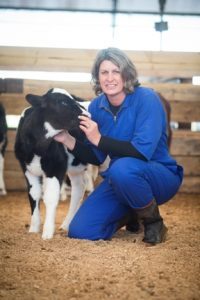Large-scale calf-rearer Joanne Leigh finds citric acid is the answer to cutting the risk of the spread of Mycoplasma bovis. Sheryl Brown reports.
Adding citric acid to whole milk is a practical and cost-effective method to reduce the risk of infecting calves with Mycoplasma bovis-infected milk.
Top-Notch Calves has recently completed milk trials with Fonterra and DairyNZ to lower the pH of whole milk using citric acid and yoghurt.
Joanne Leigh and her husband Jonathan are dairy farmers and owners of Top-Notch Calves, a large-scale Waikato calf-rearing operation. In the past 14 years they have reared 1400-8000 calves each season with no serious disease outbreaks.
‘We are not recommending yoghurt, it takes too long and it’s too temperature dependent and is too unreliable what the result will be.’
Joanne says feeding infected M bovis milk to calves is the second-biggest risk of spreading the disease, behind stock movement.

Milk that has the lowest risk of containing M bovis bacteria comes in three forms, feeding calf milk replacement powder, acidified milk or pasteurised milk. Acidification to a pH of less than 5 for at least eight hours kills M bovis bacteria.
She says feeding acidified milk is a cheaper option than buying pasteurising equipment or calf milk replacement powder, and utilises the whole milk available on farms.
“If this (acidification) is done right you can eliminate the risk of M bovis. Otherwise you’ll run into issues with (milk powder) supply and there will be a lot of milk sitting around on farms which is often a byproduct.”
Calf rearers need to achieve a pH level below 5 to ensure all the M bovis bacteria is killed. It’s best to aim to get down to a level of 4.5. Anything under 4 pH becomes unpalatable for calves.
The Top-Notch acidification trials added yoghurt and citric acid to vats of 3000l of whole milk and monitored the pH level of the milk which was then fed to three-to-four-week old calves.
The yoghurt took six days to drop the milk pH from 6.7 to 4.8, whereas adding 15kg of citric acid took two hours to drop the pH to 4.5 and adding 16.5kg dropped the pH to 4.3 immediately. The best option therefore is to use 5.5g of citric acid per litre of whole milk, or 5.5kg/1000l.
“We are not recommending yoghurt, it takes too long and it’s too temperature dependent and is too unreliable what the result will be.”
Milk below 5 pH does separate, but with gentle mixing it goes back into a homogenous solution. Continuous mixing causes coagulation as does vigorous mixing.
Joanne has found different grades of citric acid online, ranging from $38 to $98 for a 25kg bag. The pH strips can also be bought online or from farm merchant stores.
If newborn calves do not drink this milk mixture, it maybe a good idea to start them on a 50/50 mix of milk powder and citric acid treated milk for the first few weeks, she says.
Red milk is the highest-risk milk that can be fed to calves, and should be avoided altogether.
Farmers and calf-rearers alike who are buying or selling calves or milk need to consider their actions and should be doing everything in their control to minimise the risk of M bovis this season.
“People need to think about the whole industry and not their own pocket, we have to think about the long term and we have to be in this together.
“We all need to be working toward eradication.”

Joanne is encouraging all calf-rearers to develop a procedure for their staff for treating whole milk and increased biosecurity protocols onfarm.
“It’s a year that we all need to be more cautious and rethink how we do things to minimise our risk.”
At Top-Notch staff will be treating the milk with citric acid as soon as it arrives on their calf-rearing block, they will test the milk pH immediately and then test the pH level again before feeding it to the calves.
They have bought a set of kitchen scales to measure the citric acid and will stir the milk twice a week.
All visitors will be required to leave their vehicle at the entrance and clean boots in a foot bath.
For farmers and calf-rearers alike it’s about finding balance between minimising risk and shutting their business or the industry down, Joanne says.
“It’s about coming up with a plan for your property and then we’ve got to get on with the business of farming. You can only control what you can.”
Every calf-rearer must consider M bovis this season, however, and where possible they should minimise the number of places they buy calves or milk from and know exactly where those calves are coming from, she says.
NAIT transfers need to be 100% recorded, even if it’s one calf sold to the small lifestyle block owner down the road.
More on M. bovis precautions for calf-rearing, visit www.dairynz.co.nz
Milk acidification trial
Vat 1: 2x Easiyo yoghurt sachets added to 10 litres of warm water and added into 3000 litres of whole milk.
Results: No change to pH after 24 hours, took six days to reduce pH from 6.7 to 4.8.
Vat 2: 15.5kg citric acid added to 3000l whole milk.
Results: Within 24 hours pH dropped from 6.7 to 4.5 and stayed there. Milk was stirred once when citric acid was added for one hour. Milk separated, but reconstituted well after being stirred.
Vat 3: 16.5kg citric acid added to 3000l whole milk.
Results: pH dropped immediately to 4.3 and stayed there.





